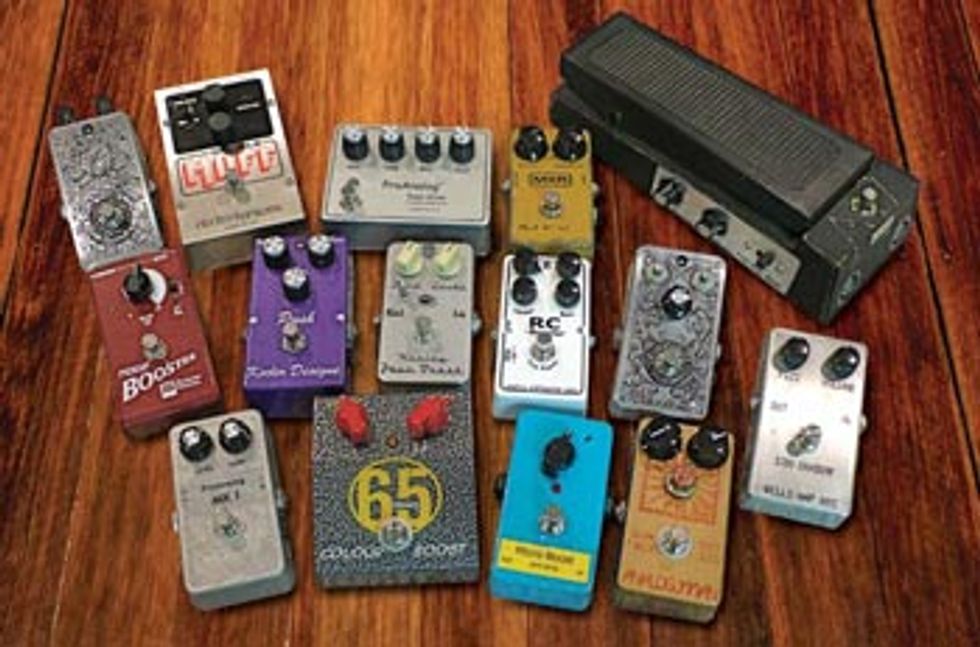These days, while at home and off of the road, I find myself sitting in quite a bit with bands and friends at clubs. This usually means plugging into someone else’s amp that I’m not familiar with, or if I bring my own, not having a real gauge on where to set my stage volume. If it’s a channel-switching amp I’m dealing with, I’ll set the clean/normal channel to sound big and clear with a lot of clarity. Then I’ll compare that to the lead overdrive channel (and fight with a buzzy-fizzy-squeally tone that ends up sounding like complete crap with no presence or clarity whatsoever). As a result, I have adopted the habit of using the clean channel only—cranked, of course—and controlling my volume from the guitar.
In general, I’m a big fan of riding my guitar’s volume control throughout the show. I’ll set my amp volume and tone around my 
But what’s even more fun is to add a gain boost pedal, or better yet, a germanium transistor type fuzz/distortion box. The latter is more “old school,” but the most versatile in my book. This is how all the greats used to do it before master volumes, back when the amps mainly had a clean sound, and you’d have to crank it before it would distort.
The germanium-type transistor is what all of these pedals have in common. Vintage pedals you may have heard of—Colorsound and Vox Tone Benders, Dallas Arbiter Fuzz Face, Univox Super Fuzz, MXR Distortion +, and of course the legendary Electro-Harmonix Big Muff—all use germanium transistors. And there are tons of great new “boutique” handmade reissues, new designs of germanium transistor circuits, Tone Bender knockoffs like Pro Analog’s Mk I, Mk II and Mk III, and Throback’s Stonebender, Treble Boosters like the 65 Colour Boost and Robert Keeley’s Java Boost, fat fuzz monsters like Analogman’s Sun Face and Way Huge’s Swollen Pickle.
Listen to the legendary recordings by Hendrix, Page, Townsend, Ritchie Blackmore and Jeff Beck. Especially live recordings: Hendrix at Monterey Pop Festival was kicking in a Fuzz Face constantly; Townsend on Live at Leeds—you hear the Univox Super Fuzz for total gonzo leads on top of his cleaner Hiwatt amplifiers; Ritchie Blackmore on Deep Purple’s live album classic, Made In Japan—“Highway Star” annihilates (I’m not sure what he’s using but it sounds like a Tone Bender circuit); Jimmy Page on “Heartbreaker” sounds like he’s kicking in his Tone Bender Mk II for the solo all the way to the climatic riff before dropping into Plant’s last verse; and Jeff Beck on “Led Boots” from the album Wired is a prime example of kicking in a serious gain boost on top of a Marshall amp, most likely a Vox Tone Bender or something similar.
The big thing you’ll notice with all of the above is that the tone gets big and fat the more it’s cranked… and when you roll off your guitar’s volume, the sound cleans up and chimes and sparkles, almost the opposite of what you get with more modern day distortion and overdrive stompboxes—definitely not what you hear with a high gain preamp/ master volume combo on most amps!
The choice of pickups on your guitar helps also. Single coil pickups seem to react more noticeably, cleaning up enormously when you turn down your guitar’s volume control… Strats and Teles, Gibsons with P-90s. But you can get that control as well with cleaner, lower-gain humbuckers.
So, if this is unfamiliar territory to your normal routine, the big thing to learn is to “ride” the volume control on your guitar and prioritize setting your amp’s volume to your rhythm playing level. When you stop playing, immediately turn your guitar to “0.” Ride your volume when you start each song (with volume around “5,” and then crank it to “10” for your solo). If you need extra, hit the stompbox for a rippin’ good time. Also, try rolling off the tone knob on your guitar a couple of notches if it gets too bright, or tweak the amp.
Rawk on.
Peter Stroud
Peter is co-founder of 65amps.
sherylcrow.com
65amps.com






![Rig Rundown: Russian Circles’ Mike Sullivan [2025]](https://www.premierguitar.com/media-library/youtube.jpg?id=62303631&width=1245&height=700&quality=70&coordinates=0%2C0%2C0%2C0)


























